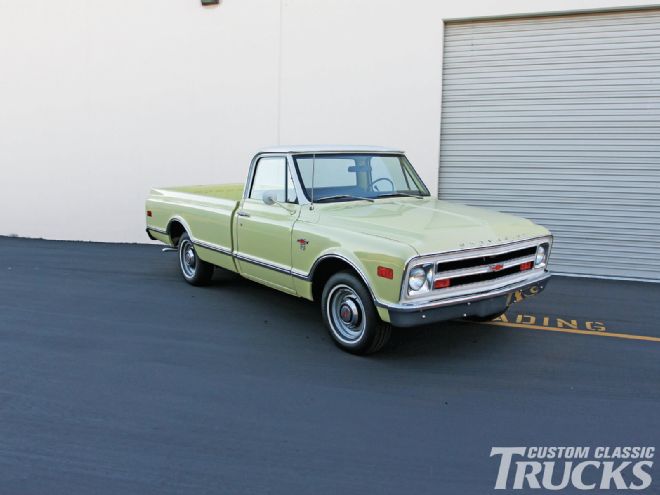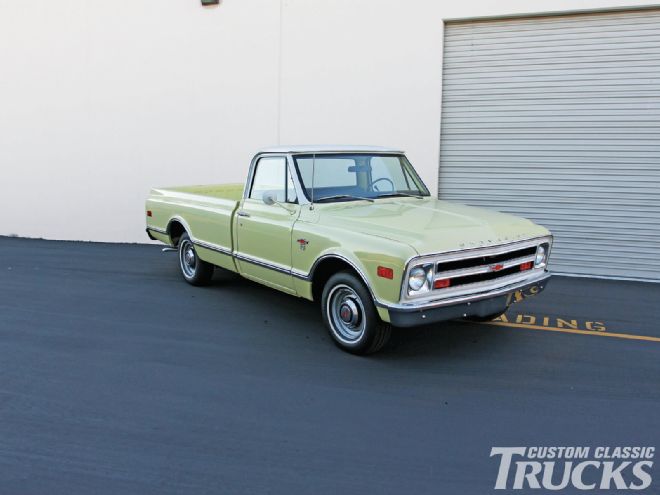
In the world of classic trucks there isn’t a truck more iconic than the 1956 Ford F-100, the "Deuce" of trucks. After 55 years of holding the throne it’s not likely its reign will ever end, but in the arena of the most popular classic truck, a new king has been crowned. It’s a trend we’ve been watching grow for years by tracking which cover truck consistently does best on the newsstand and gets the most website hits; we are talking about the range of ’67-’72 Chevrolet and GMC light-duty trucks, including pickups and other variants such as the Blazer and Suburban.

The ’67-’72’sstyling is the brainchild of GM head designer Harry Bentley Bradley. It’s actually a miracle Harry’s ultra clean design made it into production untouched before some corporate GM design committee got their collective hands on it. As it turned out, in 1969, against designer’s wishes, the ’69 got a facelift. Harry wasn’t involved though, by then he had moved on to Cadillac’s design studio. The powers that be (which means twenty guys sitting around a table and guessing at stuff) felt the original design was too delicate, and the truck should have a more aggressive look. Along with the heavy-duty nose, the ’69-up trucks were available with upper and lower moldings that gave a busier look. In retrospect the slight change in styling wasn’t a bad thing. Today the ’67-’68s are a much sought-after rarity, and the heavily trimmed ’69-ups available with a wide array of two-tone paint schemes are equally desirable.
Another example where Harry Bradley went against the wind, and time eventually bore out his convictions, was his insistence on a small rear window. This is contrary to other classic truck brands including prior years of Chevrolet and GMC where the presence of a big-window is a semi-rare and valuable option. Harry liked how the small-window produced, "a coupe quality." For years, a general consensus based in urban legend was the ’67’s small-window was banned by the government due to the formation of the Department of Transportation in 1968. Supposedly it didn’t meet rearward visibility requirements dictated by the DOT’s new laws. Currently there’s a wave of opinion building that there were some ’68 C10s built with a small-window cab. I’ve never seen one, but that doesn’t mean they don’t exist.
I got to thinking about another example from post-DOT days. Not the 1967 Austin Healy 3000 that was killed off entirely by DOT rules, but the 1968 Austin Mini Cooper "S" Mk.II. It’s another situation where there’s an ongoing argument among purists regarding production history. There were non-DOT compliant68 Mk.II Coopers, sold in the United States which are easily distinguished from ’67 Mk I Coopers, but they were built in 1967. The trick was to title them before the ’68 cutoff.
So, now where does that leave us? Does it mean small-window C10s were built only in early ’67 to beat a deadline? It’s real easy to clone a fake, and without a pristine example or factory documentation, the existence of a ’68 small-window remains an unsolved mystery. My guess is the small-window trucks didn’t sell as well as trucks equipped with a full-view rear window so dealers stopped ordering them. One has to remember that Ford trucks were offered with a larger rear window as standard equipment years ahead of GM. Both GM and Ford introduced completely redesigned models in 1967, but General Motors had already lost that bet. Proof that GM intended to continue the practice of charging more for a big rear window is listed in the first edition Price & Facts book, dated October 1966, under Optional Equipment.
"(Window), Full-View Rear: (Cabs) Code A10, List Price $40.00 Factory D&H $3.05 Mfr’s Sgt’d Retail Delvr’d $43.05. "
It’s interesting to note as I discovered on the build sheet of my ’68 GMC manufactured in September 1967, there was a box left to indicate a Panoramic rear window--confirmation that ’68 small-windows existed or just a raft of leftover blank forms?
In terms of which bed style is considered the most desirable that’s another situation where tastes have changed in recent times. Across the C10 range the trend for shortbed stepsides has diminished in comparison to the demand for ’60-’87 Fleetside shortbeds. With demand, so goes the price. A longbed Fleetside that originally sold for more new than an equivalent Fleetside shortbed, is now worth less in the custom and collector market. Focusing on ’67-’72 models there’s an even more significant difference in value when wheelbase measurements are entered into the equation. Between two ’67-’72 trucks of equal condition as the quality increases a short Fleetside can demand up to $10,000 more on the extreme end of the scale.
A good example illustrating the difference between pristine long and shortbed prices is the Meadowlark Yellow and Ivory white ’68 C10 longbed gracing these pages. The truck belongs to Reggie Jackson, and special thanks go to Reggie for allowing us to take an in-depth look that included a test drive. There was a little Internet speculation the 25,000-plus miles indicated on the odometer wasn’t correct and perhaps it was actually 125,000 miles. I have to admit, after seeing the heavy buildup of dirt and grease accumulated around the spindles and backing plates, I was starting to have my doubts. We asked how much he would let the truck go for, and the answer was low 20s. This is in contrast to the $25-$30,000 we’ve heard of pristine Fleetside shortbeds selling for. In comparison to a Styleside, Ford’s equivalent of a Fleetside, Fords were offered with steel bed floors only. Chevrolet and GMC buyers had the choice of either a steel, or wood bed floor. The E81wood bed was a no-cost option that was available in short or longbed form. On the subject of no-cost options, Z81 designated a Custom Camper nameplate which we imagine all one had to do was buy a 1Z8130 Custom Camper package, and it was theirs for free. Solid colors were also listed as a no-cost option with the selection changing slightly each year. Ice Coral Pink, considered the most rare of solid colors, was available on ’71-’72 Canadian GMCs only. Legend has it the colour was formulated to commemorate Margaret Trudeau’s hooded frock worn moments after her 1971 wedding to Canadian Prime Minister Pierre Trudeau.
Sorry about that folks, all this talk about "bone stock" trucks is starting to warp my mind. Let’s move onto the real fun. As Custom Classic Trucks’ title implies it’s all about customizing classic trucks. Since the hottest trend on the scene today is restomods we thought it might be kind of neat to combine the two hot topics and set off a proverbial mushroom cloud of sorts. One doesn’t have to look any further than Reggie’s ’68 C10 to cite a good example of some of the changes a guy might want to do to his ’67-’72 to make it his. To get a better exhaust note, and pick up a little extra horsepower, the stock single exhaust system was tossed in favor of dual exhaust. I don’t know which muffler shop Reggie had do the work, but they really did a clean job. Next on Reggie’s list of upgrades was power steering. Reggie chose to go with genuine GM parts, but this is one of those improvements where there are a lot of aftermarket options to choose from. At one point in time, Reggie had the ’68 shod in bigger meats and Rally wheels. As it is seen here, the ’68 has its original Argent silver wheels with optional 4P03AA Chromed Hubcaps.
This concludes part one of Restomods Rule. In closing, I’d like to give special thanks to Reggie Jackson for allowing me drive to his ’68 C10 and share it with Custom Classic Trucks’ valued readers. Next, I’d like to thank Jim Aust along with the rest of my good friends at www.67-72chevytrucks.com. I would have been in deep doodoo, if you guys hadn’t jumped in and helped me research this article. CCT